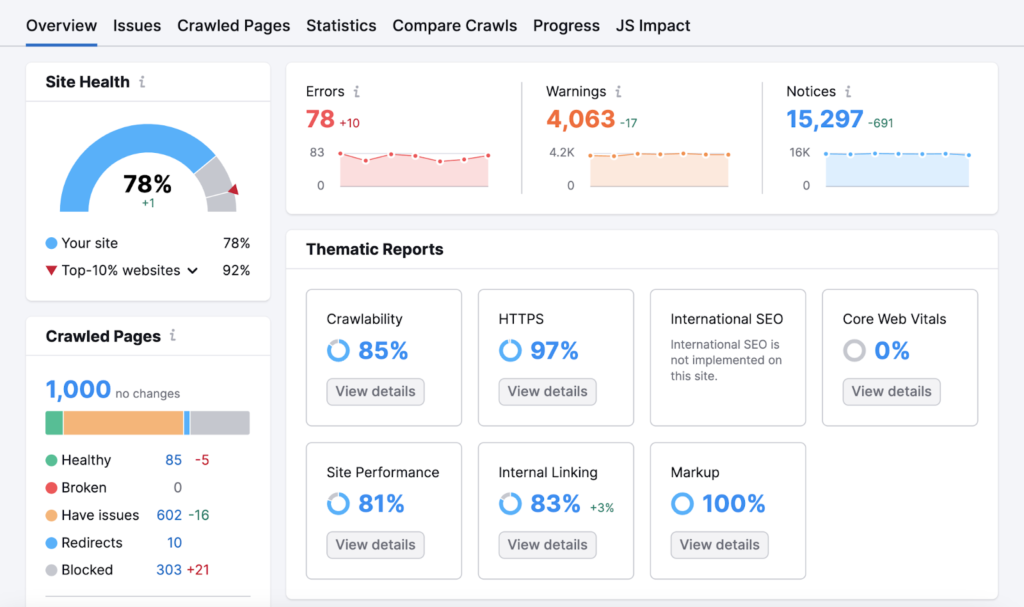Understanding the Importance of Website Health
In today’s digital age, maintaining the health of your website is crucial for online success. A healthy website not only ensures optimal performance but also enhances user experience and boosts search engine rankings. In this comprehensive guide, we will explore various aspects of website health, from technical SEO to content optimization, and provide actionable tips to keep your website in top shape.
Technical SEO: The Backbone of Website Health
1. Regular Website Audits
Performing regular website audits is essential to identify and fix potential issues. Use tools like Google Search Console, Screaming Frog, and Ahrefs to conduct thorough audits. Look for issues such as broken links, missing meta tags, and slow loading times. Addressing these issues promptly will ensure your website remains healthy and user-friendly.
2. Mobile Optimization
With the increasing use of mobile devices, ensuring your website is mobile-friendly is paramount. Implement a responsive design that adapts to different screen sizes. Use Google’s Mobile-Friendly Test tool to check your site’s mobile compatibility and make necessary adjustments to improve user experience on mobile devices.
3. Page Speed Optimization
Page speed is a critical factor for both user experience and SEO. Use tools like Google PageSpeed Insights and GTmetrix to analyze your website’s speed. Optimize images, leverage browser caching, and minimize JavaScript and CSS files to enhance page load times. A faster website not only improves user satisfaction but also positively impacts search engine rankings.
Content Optimization: Engaging and Relevant Content
1. High-Quality, Informative Content
Creating high-quality, informative content is key to engaging your audience and improving website health. Conduct thorough keyword research using tools like SEMrush and Ahrefs to identify relevant keywords. Incorporate these keywords naturally into your content to improve search engine visibility. Aim to provide valuable insights and solutions to your audience’s problems.
2. Regular Content Updates
Updating your content regularly signals to search engines that your website is active and relevant. Review and update old blog posts with new information and insights. Ensure that your content remains accurate, engaging, and aligned with current trends. Regular updates help maintain audience interest and improve search engine rankings.

3. Optimize Meta Tags and Descriptions
Optimizing meta tags and descriptions is crucial for improving click-through rates (CTR) from search engine results pages (SERPs). Craft compelling and keyword-rich meta titles and descriptions that accurately reflect the content on each page. This not only attracts more clicks but also enhances the overall SEO performance of your website.
User Experience: Enhancing Visitor Satisfaction
1. Intuitive Navigation
A well-structured website with intuitive navigation enhances user experience. Ensure that your website’s menu is easy to navigate, with clear categories and subcategories. Implement a search function to help users find information quickly. A positive user experience encourages visitors to stay longer on your site and reduces bounce rates.
2. Accessible Design
Creating an accessible website is essential for reaching a wider audience. Follow WCAG (Web Content Accessibility Guidelines) to ensure your website is usable by people with disabilities. Use alt tags for images, provide transcripts for videos, and ensure that your site is navigable using a keyboard. An accessible website not only improves user experience but also demonstrates social responsibility.
3. Engaging Visuals and Multimedia
Incorporating engaging visuals and multimedia elements can significantly enhance user experience. Use high-quality images, videos, and infographics to complement your content. Ensure that these elements are optimized for fast loading times. Engaging visuals can help convey complex information more effectively and keep visitors engaged.
Security: Protecting Your Website and Users
1. SSL Certificates
Securing your website with an SSL certificate is crucial for protecting user data and building trust. Websites with SSL certificates are marked as secure by browsers, which can enhance user confidence and improve SEO rankings. Ensure that all pages on your website are served over HTTPS.
2. Regular Security Updates
Keeping your website’s software and plugins up to date is essential for preventing security breaches. Regularly check for updates and patches from your content management system (CMS) and plugin providers. Implement a robust security plugin to monitor and protect your website from potential threats.
3. Backup Solutions
Implementing a reliable backup solution ensures that you can quickly restore your website in case of data loss or a security breach. Regularly back up your website’s data and store backups in a secure location. Consider using automated backup solutions to simplify the process and ensure regular backups.
Analytics and Monitoring: Tracking Performance
1. Google Analytics
Using Google Analytics allows you to track and analyze your website’s performance. Monitor key metrics such as traffic, bounce rate, and user behavior to gain insights into how visitors interact with your site. Use this data to make informed decisions and improve your website’s health and performance.
2. Heatmaps and User Behavior Tools
Heatmaps and user behavior tools like Hotjar and Crazy Egg provide visual insights into how users interact with your website. Analyze heatmaps to identify areas where users spend the most time and areas that may need improvement. Understanding user behavior helps you optimize your website for better engagement and conversions.
3. Regular Performance Reviews
Conducting regular performance reviews allows you to assess your website’s health and make necessary improvements. Set up periodic reviews to evaluate key performance indicators (KPIs) and adjust your strategies accordingly. Regular reviews help you stay proactive and maintain a healthy, high-performing website.
Advanced Strategies for Long-Term Website Health
1. Structured Data and Schema Markup
Implementing structured data and schema markup helps search engines understand the content on your website better. Use schema markup to provide additional context about your content, such as reviews, recipes, or business information. This can enhance your search engine listings with rich snippets, increasing click-through rates and improving overall SEO performance.
2. Internal Linking Strategy
A robust internal linking strategy is essential for improving website health. Internal links help distribute page authority throughout your site, making it easier for search engines to crawl and index your pages. Use relevant anchor text and link to related content within your website to keep users engaged and improve SEO.
3. Competitor Analysis
Conducting a competitor analysis allows you to identify strengths and weaknesses in your industry. Use tools like Ahrefs and SEMrush to analyze your competitors’ websites, keywords, and backlink profiles. By understanding what works for your competitors, you can adopt similar strategies to enhance your website’s health and performance.
4. Content Cluster Strategy
Implementing a content cluster strategy can significantly boost your website’s SEO. Organize your content around pillar pages and cluster topics to create a cohesive structure. This approach not only improves user navigation but also enhances your website’s authority on specific topics, leading to better search engine rankings.
Leveraging Social Media for Website Health
1. Social Media Integration
Integrate your website with social media platforms to expand your reach and drive traffic. Add social sharing buttons to your content, encouraging visitors to share your articles on their networks. Use social media to promote your content, engage with your audience, and drive traffic back to your website.
2. Engaging Content Formats
Experiment with different content formats to keep your audience engaged. Create videos, podcasts, and infographics to complement your written content. Share these formats on social media to reach a broader audience and drive more traffic to your website.
3. Influencer Collaborations
Collaborating with influencers in your industry can help boost your website’s visibility and credibility. Identify influencers who align with your brand values and audience. Partner with them to create and promote content, driving traffic and enhancing your website’s health.
Maintaining Website Health Through Continuous Learning
1. Staying Updated with SEO Trends
SEO is an ever-evolving field, and staying updated with the latest trends is crucial for maintaining website health. Follow industry blogs, attend webinars, and participate in SEO forums to stay informed about new developments. Implementing the latest best practices will help you stay ahead of the competition.
2. Professional Development
Investing in professional development can significantly enhance your website’s performance. Enroll in SEO courses, attend industry conferences, and seek certifications to improve your skills. Continuous learning will equip you with the knowledge to implement effective strategies for maintaining website health.
3. Networking with Industry Experts
Networking with industry experts provides valuable insights and opportunities for collaboration. Join professional groups, attend industry events, and engage with thought leaders in your field. Building a network of industry contacts can lead to new ideas and strategies for improving your website’s health.
The Role of Analytics in Sustaining Website Health
1. Conversion Rate Optimization (CRO)
Conversion Rate Optimization (CRO) focuses on increasing the percentage of website visitors who take the desired action, whether it’s making a purchase, filling out a form, or subscribing to a newsletter. Use tools like Google Optimize and Optimizely to run A/B tests on your website elements. Analyze user behavior to identify areas for improvement, such as call-to-action buttons, landing pages, and overall site design. Implementing effective CRO strategies can significantly enhance user experience and increase conversion rates.
2. Advanced Segmentation
Advanced segmentation in analytics allows you to categorize your audience based on specific criteria, such as behavior, demographics, or acquisition channels. Use Google Analytics to create detailed segments and gain insights into different user groups. This enables you to tailor your content and marketing strategies to meet the unique needs of each segment, thereby improving engagement and driving conversions.
3. Event Tracking
Event tracking helps you monitor user interactions with specific elements on your website, such as button clicks, video plays, or form submissions. Set up event tracking in Google Analytics to gather data on how users interact with your site. This information can help you identify which elements are performing well and which need optimization, ultimately contributing to a healthier website.
Building a Robust Backlink Profile
1. High-Quality Backlinks
Acquiring high-quality backlinks from authoritative websites is crucial for improving your website’s SEO and overall health. Focus on building relationships with industry influencers, bloggers, and reputable websites to secure valuable backlinks. Guest posting, creating shareable content, and participating in industry forums can help you earn these backlinks, boosting your site’s authority and search engine rankings.
2. Monitoring Backlink Quality
Regularly monitoring the quality of your backlinks is essential to ensure they continue to benefit your website. Use tools like Ahrefs, Moz, and SEMrush to analyze your backlink profile. Identify and disavow any toxic or low-quality links that could harm your site’s SEO. Maintaining a clean and high-quality backlink profile helps improve your website’s health and authority.
3. Internal Linking Best Practices
In addition to external backlinks, internal linking plays a crucial role in maintaining website health. Ensure that your internal links are relevant and provide value to users. Use keyword-rich anchor text to help search engines understand the context of linked content. A strategic internal linking structure enhances site navigation, distributes page authority, and improves SEO.
Utilizing User Feedback for Continuous Improvement
1. Collecting User Feedback
Collecting user feedback is vital for understanding how visitors perceive your website and identifying areas for improvement. Use surveys, feedback forms, and live chat tools to gather insights from your audience. Analyzing this feedback can reveal pain points, usability issues, and content gaps, allowing you to make data-driven decisions to enhance your website’s health.
2. Implementing Feedback
Implementing user feedback demonstrates that you value your audience’s opinions and are committed to improving their experience. Prioritize feedback based on its impact on user experience and business goals. Make necessary adjustments to your website’s design, content, and functionality based on the feedback received. Regularly iterating and refining your website ensures it remains user-centric and high-performing.
3. Encouraging User Engagement
Encouraging user engagement through interactive elements can enhance the overall health of your website. Incorporate features such as polls, quizzes, and discussion forums to foster community interaction. Engaged users are more likely to spend time on your site, share your content, and convert into loyal customers. High levels of engagement signal to search engines that your website provides valuable content, positively impacting SEO.
Leveraging Automation for Efficiency
1. Marketing Automation Tools
Marketing automation tools like HubSpot, Mailchimp, and Marketo can streamline your marketing efforts and improve website health. Automate tasks such as email campaigns, social media posting, and lead nurturing to save time and ensure consistent communication with your audience. Effective use of marketing automation can enhance user engagement, drive traffic, and increase conversions.
2. Automated Reporting
Automated reporting tools help you stay informed about your website’s performance without manual effort. Use tools like Google Data Studio and Tableau to create automated reports that provide real-time insights into key metrics. Regularly reviewing these reports allows you to identify trends, track progress, and make informed decisions to maintain your website’s health.
3. Chatbots and AI
Implementing chatbots and AI-driven tools can significantly enhance user experience on your website. Chatbots provide instant support to visitors, answering common questions and guiding them through your site. AI tools can personalize content and recommendations based on user behavior, increasing engagement and satisfaction. Leveraging these technologies helps ensure a seamless and efficient user experience.
Optimizing for Voice Search
1. Natural Language Processing
Voice search is becoming increasingly popular, thanks to the rise of digital assistants like Siri, Alexa, and Google Assistant. To optimize for voice search, focus on natural language processing. Voice searches are often conversational and phrased as questions. Integrate long-tail keywords and question phrases into your content to align with how people speak.
2. Answering Common Questions
Create content that answers common questions related to your industry. Use the “People Also Ask” section of Google search results to identify frequently asked questions. Develop a FAQ page or integrate these questions and answers into your blog posts and articles. This strategy helps capture voice search traffic and improves your chances of appearing in featured snippets.
3. Local SEO for Voice Search
Voice searches often have local intent, such as finding nearby businesses or services. Ensure your website is optimized for local SEO by claiming your Google My Business listing, including accurate location information, and encouraging customer reviews. Use local keywords and create content focused on local events and news to attract voice search traffic.
Enhancing Content Distribution and Promotion
1. Leveraging Email Marketing
Email marketing remains one of the most effective ways to distribute and promote your content. Build a robust email list and segment it based on user interests and behaviors. Use personalized and engaging email campaigns to promote your latest blog posts, products, and services. A well-executed email marketing strategy can drive traffic, increase engagement, and boost conversions.
2. Utilizing Content Syndication
Content syndication involves republishing your content on third-party platforms to reach a broader audience. Partner with reputable websites and industry publications to syndicate your articles. Ensure that syndicated content includes canonical tags to prevent duplicate content issues and drive traffic back to your original site. Content syndication can enhance your website’s visibility and authority.
3. Social Media Advertising
Investing in social media advertising can significantly amplify your content distribution efforts. Platforms like Facebook, Twitter, LinkedIn, and Instagram offer targeted advertising options to reach specific audience segments. Promote your high-performing content through paid ads to increase visibility, drive traffic, and generate leads.
Creating a Comprehensive Content Calendar
1. Planning Content Strategically
A comprehensive content calendar helps you plan and organize your content strategy effectively. Outline your content themes, topics, and publication dates for the upcoming months. Align your content with seasonal trends, industry events, and business goals. Strategic planning ensures a steady flow of relevant content that keeps your audience engaged.
2. Collaborating with Your Team
Involve your marketing, SEO, and content teams in the content planning process. Collaborate to brainstorm ideas, assign tasks, and set deadlines. Using project management tools like Trello, Asana, or Monday.com can streamline the workflow and ensure everyone is on the same page. Team collaboration enhances creativity and productivity, leading to higher-quality content.
3. Reviewing and Adjusting the Calendar
Regularly review your content calendar to assess its effectiveness. Analyze performance metrics such as traffic, engagement, and conversions to identify successful content types and topics. Adjust your calendar based on these insights to optimize your content strategy. Flexibility in your planning process ensures you can adapt to changing trends and audience preferences.
Implementing Advanced SEO Techniques
1. Latent Semantic Indexing (LSI) Keywords
Incorporating LSI keywords helps search engines understand the context and relevance of your content. Use tools like LSI Graph and Google’s related searches to identify related terms and phrases. Integrate these keywords naturally into your content to enhance its depth and improve your search engine rankings.
2. Optimizing for Featured Snippets
Featured snippets appear at the top of Google’s search results and can significantly increase your website’s visibility. Structure your content to answer specific questions clearly and concisely. Use bullet points, numbered lists, and headers to organize information. Aim to provide comprehensive answers that can be easily extracted as snippets.
3. Leveraging Rich Media
Rich media, including images, videos, and infographics, can enhance user engagement and improve SEO. Optimize images with descriptive file names and alt text. Create video content that complements your written content and host it on platforms like YouTube. Incorporate infographics to visually represent data and complex concepts. Rich media not only attracts visitors but also keeps them engaged longer.
Focusing on User Intent
1. Understanding User Intent
Understanding user intent is crucial for creating content that meets your audience’s needs. Analyze search queries to determine whether users are looking for information, seeking to make a purchase, or navigating to a specific site. Tailor your content to address these intents, providing relevant and valuable information.
2. Creating Intent-Based Content
Develop different types of content to match various user intents. For informational intent, create in-depth guides, tutorials, and blog posts. For navigational intent, optimize your site structure and internal linking. For transactional intent, create compelling product pages, reviews, and comparisons. Matching content to user intent enhances user satisfaction and improves SEO.
3. Monitoring and Adapting to Intent Changes
User intent can change over time, influenced by trends, seasons, and external factors. Regularly monitor search data and user behavior to identify shifts in intent. Use tools like Google Trends and Search Console to stay updated. Adapt your content strategy to align with these changes, ensuring your website remains relevant and valuable.
Conclusion
Achieving and maintaining optimal website health is an ongoing process that encompasses a wide range of strategies. By focusing on technical SEO, content optimization, user experience, security, and leveraging advanced techniques, you can ensure your website remains a top performer in search engine rankings. Continuously monitor your website’s performance, stay updated with industry trends, and be ready to adapt to changes to maintain long-term success.








